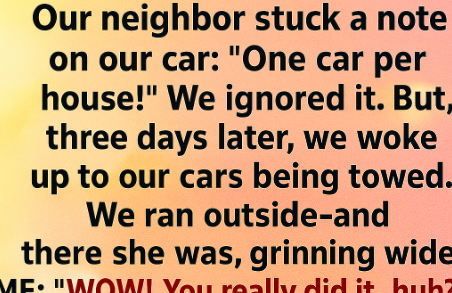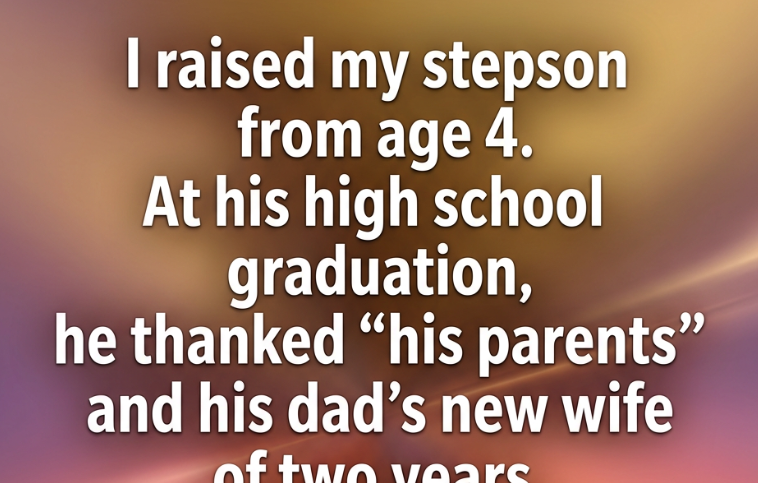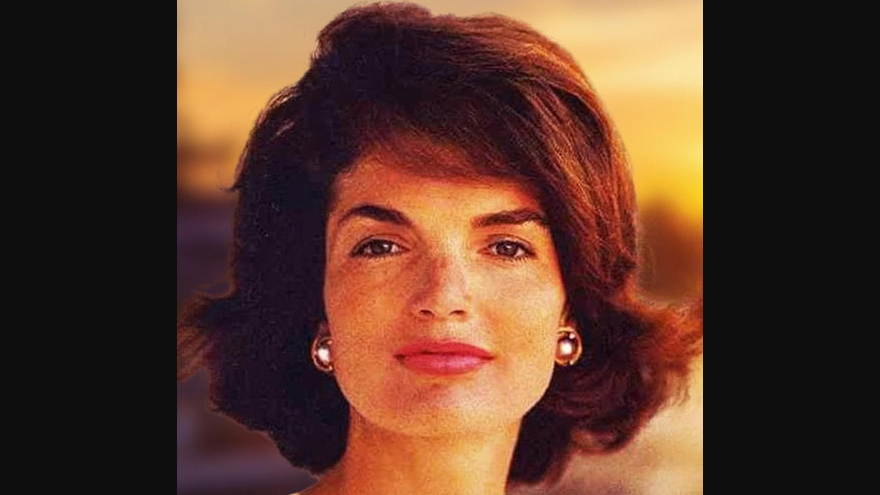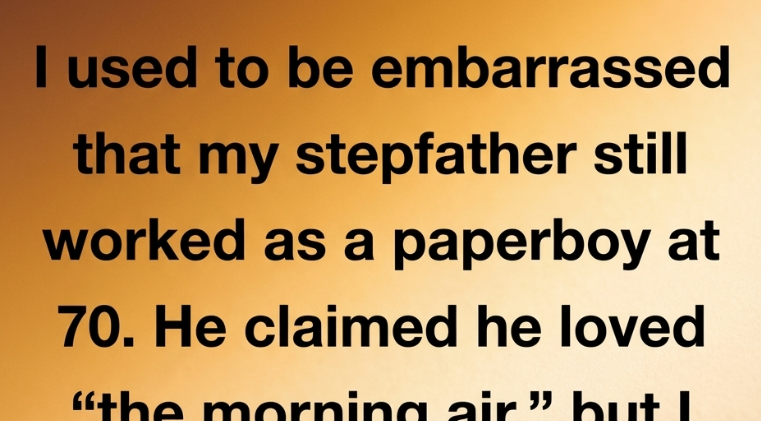Our new neighbor had grown increasingly frustrated with parking arrangements from the very first day our family settled into the home. She firmly maintained that each residence along our quiet street ought to accommodate a single vehicle at most, despite the complete absence of any official guidelines supporting her view. One peaceful evening, as the sun dipped below the horizon, we discovered a neatly handwritten note affixed securely to the windshield of our primary automobile. The message declared in bold letters: “One car per house! Relocate the additional vehicle immediately or face consequences!” We shared a lighthearted chuckle over the discovery, dismissing the warning as nothing more than an empty gesture from someone overly passionate about neighborhood aesthetics.
After all, both of our vehicles rested perfectly within legal boundaries directly in front of our property, fully compliant with local ordinances and causing no obstruction to traffic or access. Three days passed in relative calm, filled with the usual routines of unpacking boxes, arranging furniture, and getting acquainted with the surroundings. Then, on a crisp morning, the air filled with the rumble of powerful engines and the metallic clanging of heavy chains echoing through the neighborhood. We bolted from the house in our pajamas, hearts racing, only to witness the unbelievable sight of both our cherished cars being lifted onto the beds of massive tow trucks, their operators moving with practiced efficiency.
There, positioned proudly on the sidewalk with arms crossed and a triumphant grin spreading across her features, stood our neighbor, radiating satisfaction at her bold intervention. “There we go,” she announced with a sharp nod, her voice carrying a tone of undeniable victory. “Perhaps this experience will encourage everyone to respect the established norms around here!” I paused for a moment, absorbing the scene, and found myself letting out a genuine, amused laugh that bubbled up from deep within.
“Impressive commitment,” I responded calmly, drawing out the words to emphasize the irony unfolding before us. “You actually followed through on that note, didn’t you?” Her confident expression wavered slightly, a flicker of uncertainty crossing her eyes. “Why the laughter?” she demanded, tilting her head in confusion. I lifted my shoulders in a casual shrug, struggling to contain the growing smile. “No particular reason,” I explained smoothly. “Except for the detail that your actions have now created a financial obligation on your part amounting to $25,000.”
Her gaze expanded in shock, pupils dilating as the reality sank in. “Excuse me? How could that possibly be true?” I gestured toward the distinctive permit tag prominently displayed on the dashboard of our lead vehicle, a marker she had evidently overlooked in her haste. “This official tag identifies our automobiles as participants in a protected government initiative dedicated to the preservation of classic and specialty automobiles. Any unauthorized removal triggers substantial penalties, including hefty fines that activate automatically upon verification. The towing service representatives have already confirmed the error through their system, and standard procedure dictates that they transfer the full expense directly to the individual who initiated the complaint—namely, you.”
The vibrant hue faded rapidly from her cheeks, leaving her complexion pale and drawn as she struggled to form coherent words. “I-I had no idea about any of that…” she muttered, her voice trailing off into the morning breeze. “Exactly,” I replied with a broad, satisfied grin. “In the future, consider verifying facts before enforcing personal interpretations of community standards.” The tow truck drivers, after a quick consultation and some apologetic nods in our direction, carefully lowered our vehicles back to the pavement, unhooking the chains with deliberate care before climbing into their cabs and departing the scene without further incident.
From that pivotal moment onward, our neighbor ceased all commentary regarding parking matters in the area. She no longer waved enthusiastically or engaged in casual driveway conversations. Whenever our paths crossed—whether during evening walks with the dog, morning coffee runs, or weekend yard work—she would avert her gaze, quicken her pace, and pretend absorption in her phone or the scenery. The incident served as a powerful reminder of how assumptions can lead to unexpected repercussions, transforming a simple disagreement into a costly learning opportunity.
Reflecting on the event in the days that followed, we appreciated the layers of protection afforded by thoughtful government programs designed to safeguard unique automotive heritage. These initiatives, often overlooked in everyday life, play a vital role in encouraging enthusiasts to maintain and showcase historical vehicles without fear of arbitrary interference. Our collection included a meticulously restored 1965 Mustang convertible, its sleek lines and chrome accents turning heads wherever it traveled, alongside a rare 1972 Volkswagen Beetle customized with period-appropriate modifications that honored its iconic design. Both cars represented years of dedicated restoration work, sourcing original parts from specialized suppliers, attending automotive shows, and participating in community events that celebrated mechanical craftsmanship.
The permit program itself emerged from a broader effort to promote cultural preservation, recognizing that classic cars contribute to educational outreach, historical storytelling, and even economic benefits through tourism and local gatherings. Participants receive not only legal safeguards against unwarranted towing but also access to resources like expert consultations, discounted insurance options, and invitations to exclusive exhibitions. Enrolling requires detailed documentation, including proof of authenticity, maintenance records, and photographs highlighting unique features, ensuring that only genuine specialty vehicles qualify for the benefits.
In our case, the tags arrived after a thorough application process involving inspections by certified appraisers who verified the cars’ eligibility based on age, rarity, and condition. The Mustang, for instance, boasted an original inline-six engine rebuilt to factory specifications, complete with matching numbers that authenticated its provenance. The Beetle featured a custom paint scheme inspired by vintage rally editions, with reinforced chassis components that enhanced safety while preserving aesthetic integrity. These details, far from mere hobbies, formed part of a passionate pursuit that connected us to generations of automotive innovators.
Neighbors who learned of the story through casual conversations expressed a mix of amusement and admiration, often sharing their own tales of quirky community dynamics. One family down the block recounted how they navigated similar parking tensions by installing designated guest spots marked with friendly signs, fostering goodwill without escalating conflicts. Another resident highlighted the importance of reviewing homeowners’ association documents—or the lack thereof in our unrestricted subdivision—to clarify boundaries and avoid misunderstandings.
Over time, the episode evolved into a neighborhood anecdote, retold at block parties and holiday gatherings with embellishments that grew funnier with each iteration. Children in the area, fascinated by the gleaming classics now parked proudly in our driveway, would wave excitedly as we cruised by on weekend drives, the rumble of the engines evoking smiles and waves from porches lined with pumpkins in autumn or holiday lights in winter. The experience reinforced the value of clear communication, prompting us to post informative flyers about the permit program at the community bulletin board, educating others on protections available for similar interests.
Our neighbor’s avoidance, while initially awkward, gradually softened into neutral coexistence. She tended her flower beds with the same vigor, her roses blooming vibrantly each spring, and occasionally left excess produce from her garden on shared tables during harvest season—a subtle gesture of truce, perhaps. Life on the street returned to its rhythmic flow: bicycles weaving between sidewalks, dogs barking in playful chase, and the occasional ice cream truck melody drifting through open windows on warm afternoons.
Ultimately, the situation illustrated how knowledge empowers individuals to respond gracefully under pressure, turning potential adversity into an affirming outcome. Patience allowed the facts to reveal themselves naturally, while the structured safeguards ensured fairness prevailed. Classic car ownership, beyond the thrill of the drive, embodies a commitment to history, innovation, and community engagement, enriching daily life in ways that extend far beyond the garage.
Expanding on the broader appeal of specialty vehicles, many enthusiasts form clubs and online forums where members exchange tips on restoration techniques, source rare components, and organize group outings to museums or scenic routes. These gatherings often include educational workshops on topics like engine tuning, bodywork preservation, and sustainable maintenance practices that align with modern environmental standards. Electric conversion kits for classics, for example, gain popularity among owners seeking to blend vintage charm with eco-friendly operation, reducing emissions without sacrificing character.
Government programs supporting such endeavors vary by region but commonly offer tax incentives, reduced registration fees, and exemptions from certain emissions testing for vehicles meeting historical criteria. In our state, the initiative traces back to legislation passed in the late 1990s, aimed at countering urban sprawl’s impact on cultural artifacts by protecting mobile pieces of history. Applicants submit portfolios detailing the vehicle’s significance, whether through celebrity ownership, racing pedigree, or design innovation that influenced subsequent models.
Our Mustang qualified due to its representation of an era when American muscle cars symbolized freedom and engineering prowess, its V8 options inspiring countless imitations. The Beetle earned its spot through association with counterculture movements, its compact efficiency promoting accessible mobility worldwide. Displaying these cars at local events draws crowds eager to learn about automotive evolution, sparking conversations that bridge generations—from grandparents reminiscing about first drives to youngsters exploring career paths in mechanical engineering.
The towing mishap, in hindsight, highlighted the program’s effectiveness in deterring misuse while compensating affected parties promptly. Towing companies, bound by contracts and liability insurance, conduct rapid verifications upon dispatch, scanning databases for protected tags to avoid penalties. In this instance, the quick reversal minimized inconvenience, with our vehicles sustaining no damage thanks to professional handling.
Community responses to parking challenges evolve creatively in many areas. Some neighborhoods implement shared parking apps allowing residents to reserve spots for visitors, reducing friction. Others designate overflow zones in nearby parks or lots, accommodating growing households without altering streetscapes. Education campaigns, distributed via newsletters or social media groups, clarify municipal codes, empowering everyone to contribute positively.
As seasons changed, our driveway became a subtle point of pride, the cars gleaming under sunlight or dusted with fresh snow, symbols of resilience and reward. Neighbors occasionally inquired about joining the permit program, inspired to revive family heirlooms gathering dust in garages. Workshops hosted by local auto shops provided hands-on guidance, from polishing chrome to troubleshooting carburetors, fostering bonds over shared passions.
The original note, preserved as a memento in a frame tucked away in the home office, serves as a humorous reminder that rules thrive when grounded in reality rather than whim. Fate, in its unpredictable way, delivered a lesson in humility and research, ensuring harmony prevailed without further drama.
In essence, embracing informed approaches to daily interactions cultivates environments where everyone benefits. Specialty vehicle programs exemplify proactive governance, protecting interests while promoting cultural continuity. Our story, woven into the fabric of neighborhood lore, continues to entertain and educate, proving that sometimes, the most effective resolutions arise from simply knowing the details.






